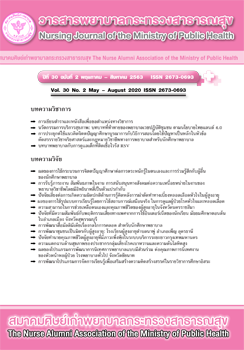Nurses’ Role in the Care of Children with Respiratory Syncytial Virus Infection
Main Article Content
Abstract
Respiratory Syncytial Virus (RSV) infection is the leading cause of childhood hospitalization and mortality. Epidemics of RSV have been found during the wet season and winter. The infection occurs in the lower respiratory tract and may be severe among infants and children aged less than two years old. RSV infection may cause childhood hospitalization with respiratory failure, which is a severe complication of RSV infection. The purpose of this article is to provide guidelines for nursing care practice for children hospitalized with RSV infection including how to monitor RSV complications and hypoxemia, promote health and well-being, and give health education to reduce the recurrence rate of RSV infection. This article will enhance the comprehension of caring for children with RSV infection in terms of family-centered care. Furthermore, discussions between nurses and parents would be beneficial for improving the quality of care and better quality of life among children with RSV infection.
Article Details
บทความและรายงานวิจัยในวารสารพยาบาลกระทรวงสาธารณสุข เป็นความคิดเห็นของ ผู้เขียน มิใช่ของคณะผู้จัดทำ และมิใช่ความรับผิดชอบของสมาคมศิษย์เก่าพยาบาลกระทรวงสาธารณสุข ซึ่งสามารถนำไปอ้างอิงได้
References
2. Hockenberry MJ, Wilson D. Wong’s essentials of pediatric nursing 9: Wong’s essentials of pediatric nursing: Elsevier Health Sciences; 2013.
3. Drysdale SB, Green CA, Sande CJ. Best practice in the prevention and management of paediatric respiratory syncytial virus infection. Therapeutic advances in infectious disease. 2016;3(2):63-71.
4. Shi T, Balsells E, Campbell S, Campbell H, Nair H, McAllister DA, et al. Global, regional, and national disease burden estimates of acute lower respiratory infections due to respiratory syncytial virus in young children in 2015: a systematic review and modelling study. The Lancet. 2017;390(10098):946-58.
5. Ralston SL, Lieberthal AS, Meissner HC, Alverson BK, Baley JE, Gadomski AM, et al. Clinical practice guideline: the diagnosis, management, and prevention of bronchiolitis. American Academy of Pediatrics. 2014:1474-502. Doi:10.1524/peds.2014-2742.
6. Suntarattiwong P, Sojisirikul K, Sitaposa P, Pornpatanangkoon A, Chittaganpitch M, Srijuntongsiri S, et al. Clinical and epidemiological characteristics of respiratory syncytial virus and influenza virus associated hospitalization in urban Thai infants. J Med Assoc Thai. 2011;94(Suppl 3):S164-71.
7. Bunjoungmanee P, Rotejaratpaisan A, Tangsathapornpong A. Epidemiology, clinical manifestation and risk factors of respiratory syncytial virus infection in children at Thammasat University Hospital. Thammasat Medical Journal. 2016;16(3):370-8. (in Thai).
8. Scheltema NM, Gentile A, Lucion F, Nokes DJ, Munywoki PK, Madhi SA, et al. Global respiratory syncytial virus-associated mortality in young children (RSV GOLD): A retrospective case series. The Lancet Global Health. 2017;5(10):984-91.
9. The Thai Society of Pediatric Respiratory and Critical Care Medicine. Pediatric practice guideline in acute respiratory tract infection 2019: The Royal College of Pediatricians of Thailand & Pediatric Society of Thailand; 2019. (in Thai).
10. Supsung A, Jintrawet U, Lamchang S. Factors related to caregiver practices in caring for hospitalized toddler with acute illness. Journal of The Royal Thai Army Nurses. 2017; 18(2): 140-8. (in Thai).
11. Xing Y, Proesmans M. New therapies for acute RSV infections: where are we? European journal of pediatrics. 2019;178(2):131-8.
12. DiBlasi RM. Clinical controversies in aerosol therapy for infants and children. Respiratory Care. 2015; 60(6):894-916.
13. Schweitzer JW, Justice NA. Respiratory Syncytial Virus Infection (RSV). StatPearls [Internet]: StatPearls Publishing; 2018. [cited 2019 Nov 16]. Available from: https://www.ncbi.nlm.nih.gov/books/NBK459215/
14. WHO. Oxygen therapy for children: a manual for health workers. Geneva, Switzerland: WHO;2016.
15. Zhang L. Nebulised hypertonic saline solution for acute bronchiolitis in infants. Cochrane database of systematic reviews.2017(12).
16. Cavaye D, Roberts DP, Saravanos GL, Hsu ZY, Miyajima R, Randall LE, et al. Evaluation of national guidelines for bronchiolitis: agreements and controversies. Journal of paediatrics and child health. 2019; 55(1):25-31.
17. Corneli H, Zorc J, Holubkov R, Bregstein J, Brown K, Mahajan P, et al. Bronchiolitis study group for the pediatric emergency care applied research network bronchiolitis: clinical characteristics associated with hospitalization and length of stay. Pediatr Emerg Care. 2012;28(2):99-103.
18. Nierengarten MB. Bronchiolitis guidelines: diagnosis, management, and prevention. Contemporary Pediatrics. 2015;32(1):20-2.
19. Ari A, Restrepo RD. Aerosol delivery device selection for spontaneously breathing patients: 2012. Respiratory care. 2012;57(4):613-26.
20. Fauroux B, Simões EA, Checchia PA, Paes B, Figueras-Aloy J, Manzoni P, et al. The burden and long-term respiratory morbidity associated with respiratory syncytial virus infection in early childhood. Infectious diseases and therapy.2017;6(2):173-97.
21. Jartti T, Korppi M. Rhinovirus-induced bronchiolitis and asthma development. Pediatric Allergy and Immunology.2011;22(4):350-5.
22. Gidaris D, Urquhart D, Anthracopoulos M. They said it was bronchiolitis; is it going to turn into asthma doctor? Respirogy.2014;19:1158-64.

